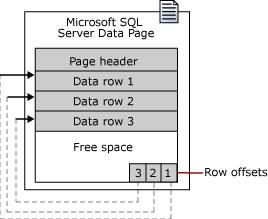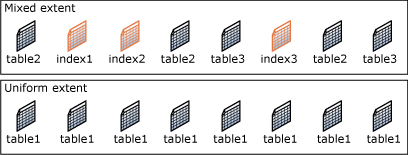以下的文章主要是对SQL Server中页与SQL Server盘区的正确理解,在SQL Server数据库中其最基本的存储单元是页(page)。系统给数据库文件(.mdf .ndf)分配的磁盘空间逻辑上被分解为从0..n的多个编号连续的页。
磁盘的I/O操作是在页级水平完成的,也就是说,SQL Server每次读或写整个的数据页(data page).
盘区(Extent)是物理上连续的8个页,这样便于有效地管理页,所有的页都存储在SQL Server盘区。
页(Pages)
在SQL Server中,页的大小为8KB。这意味着1M字节可以有128页。每页有一个96字节的页头(Header),页头用来存储页的系统信息,具体包括:页编号,页类型、该页剩余空闲空间、
下面表列出了SQL Server的数据文件中所用的页的类型
page Type contents
Data Data rows with all data, except text, ntext, image, nvarchar(max), varchar(max), varbinary(max), and xml data, when text in row is set to ON.
Index Index entries.
Text/Image Large object data types: * text, ntext, image, nvarchar(max), varchar(max), varbinary(max),
and xml dataVariable length columns when the data row exceeds 8 KB: * varchar, nvarchar, varbinary, and sql_variant
Global Allocation Map, Shared Global Allocation Map Information about whether extents are allocated.
Page Free Space Information about page allocation and free space available on pages.
Index Allocation Map Information about extents used by a table or index per allocation unit.
Bulk Changed Map Information about extents modified by bulk operations since the last BACKUP LOG statement per allocation unit.
Differential Changed Map Information about extents that have changed since the last BACKUP DATABASE statement per allocation unit.
- 1.
- 2.
- 3.
- 4.
- 5.
- 6.
- 7.
- 8.
- 9.
- 10.
数据行在页头之后,按顺序存储在页中。在页的底部有一个记录每行偏移量的表格,这个偏移量表格的每行对应于页中的每行记录。每个偏移量用来表示每行记录的***个字节与页开始的
位置的距离。偏移量表格中行与页中行的顺序相反。

盘区(Extents)
盘区是管理磁盘空间的基本单元。每个SQL Server盘区是由物理上连续的8个页构成,也就是说,每兆磁盘空间可以容纳16个盘区。
为了更有效分配空间,SQL Server不为小数据量的表分配一个完整的盘区。SQL Server有两种类型盘区:
uniform extents:由一个对象拥有,该盘区中8个页只能有拥有者来使用
Mixed extents:可以由8个对象拥有,8个页可以由不同对象使用。
一个新表或索引通常是从混合SQL Server盘区中分配页,当表或索引的大小增长超过了8页,那么就以uniform extents方式进行分配。当在已存在的表上创建索引,如果表中行对应的索引大小超过了8页,也以uniform extents方式分配空间。

上述的相关内容就是对理解SQL Server中页和SQL Server盘区的描述,希望会给你带来一些帮助在此方面。
【编辑推荐】

























